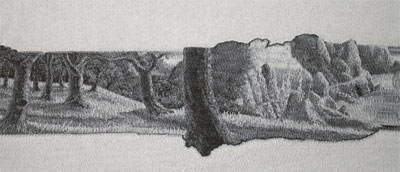
A number of artists have started using textiles and needlework to explore the relationship between computer culture and craft. Here on Rhizome, we've recently covered Cass Fino-Radin, Sabrina Gschwandtner, Cat Mazza, and Cody Trepte, among others employing "traditional media" in the service of a technological critique. Not to be left out of this group is Christy Matson, a Chicago-based artist who takes this investigation to even more self-reflexive heights. Matson's work may not look high tech, but it responds directly to media culture and is often made using a Jacquard Loom, a mechanical device that is important in the proto-history of computing. Many of the artist's projects involve building feedback loops between the sonic experiences of making and viewing her work. Recordings of the weaving process are algorithmically translated into binary yes/no, on/off, or true/false patterns and translated into images in the form of thread color choice, needle behavior, and other factors. The artist includes copper wires in these weavings to act as amplifiers or antennae for further sonic transmissions. See, for example, Movements, in which the viewer's hand is meant to rove as a sort of playhead on what is posited as a 4-channel audio installation. The same questions are raised in her work, Digital Synesthesia, which looks at similarities in the abilities (one might even say tendencies) of both the human brain and the computer to conflate sound and image. To her credit as a dedicated artist, these are issues Matson works to flesh out again and again, even exploiting the repetition of the line-by-line weaving process as an ironic take on the re-spinning of these narratives. When she explored synaesthesia in Soundw(e)ave (a piece whose title conveys her obvious love of word play), she wrote that "This transmutability [between images and sounds] of information in the digital world initially seems to be in opposition to the ways that humans experience the physical world," but is, in fact, quite natural. Speaking of the physical world, her weaving-together of cotton and rayon (or natural and artificial fibers) in Loomscapes seems perhaps her most visually compelling argument of the relationship between traditional media and digital production. Following from the long tradition of tapestries that depict battle scenes and other historical culture clashes, Matson's wall hangings pull landscape imagery from LucasArts' early-90s computer game, LOOM, to collage together images absent of figures, but instead foregrounding the game's beautiful backdrops. In a sense, the beauty and conceptual quandaries that make Matson's work so compelling are nicely summed up in her own words, written about her work, Either/Or: "[This] is a series of work that explores the grey areas that technically should not exist, but often do, in absolute systems." The piece creates what looks to the human eye like a band of grey, where thousands of black and white strings are loosely knotted together. Here, the seemingly hard differences between bodily and machine perception are made messy, but prove worth unraveling. - Marisa Olson
Christy Matson, Loomscapes, 2007